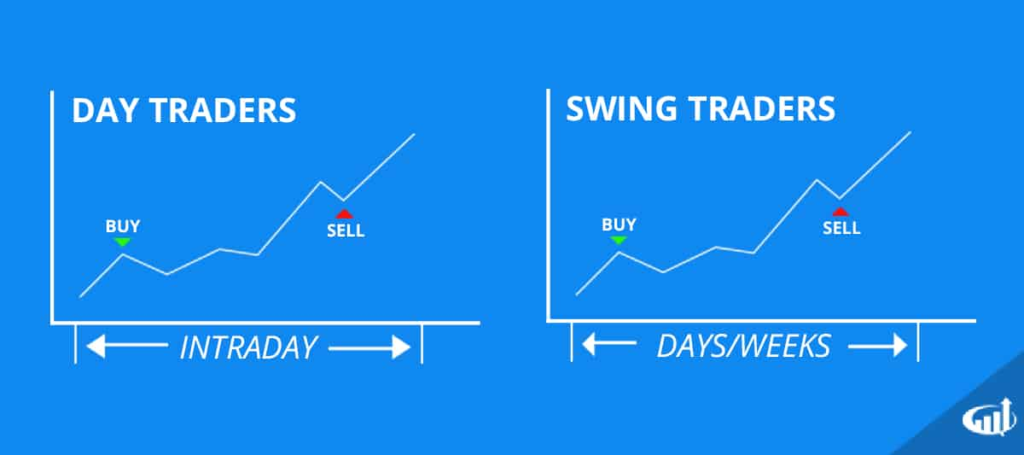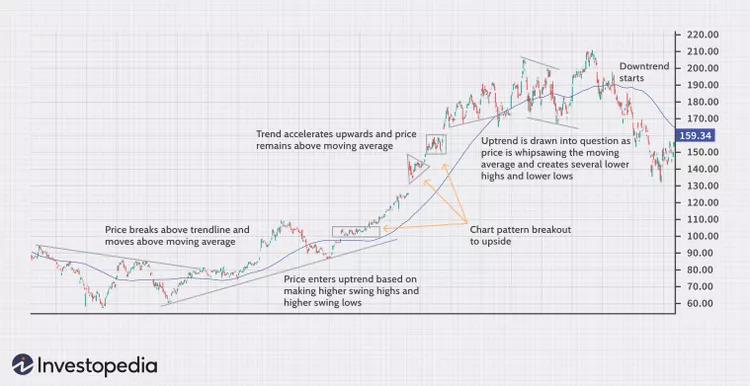4장: 다양한 목적을 위한 기술적 분석: 데이 트레이딩, 스윙 트레이딩, 추세 트레이딩
수업 학습 목표:
소개: This chapter delves into the versatile world of Technical Analysis for Different Trading Purposes. By distinguishing among day, swing, and trend trading, we explore how technical analysis serves as a flexible toolkit catering to various trading styles and timelines. Understanding the nuances of each trading approach will empower you to tailor your strategies to align with your goals, risk tolerance, and time commitment, enhancing your proficiency in navigating the financial markets.
- Differentiate Between Day, Swing, and Trend Trading: Grasp the core characteristics, goals, and strategies of each trading style to better understand their applications and potential benefits.
- Apply Technical Analysis Tools Across Trading Styles: Learn to leverage technical analysis tools effectively, whether aiming for quick profits in day trading, capturing swings in the market, or following long-term trends.
- Weigh the Pros and Cons of Each Trading Style: Evaluate the advantages and challenges of day, swing, and trend trading to make informed decisions that match your trading preferences and lifestyle.
소개
Not all traders are the same, and the beauty of technical analysis lies in its flexibility. It can cater to different trading styles and timelines. This chapter takes you through the three primary types of trading: day, swing, and trend trading. We’ll examine their differences, explore some example strategies for each, and weigh their pros and cons.
A. Day Trading

수치: A photo capturing a man working on a laptop with the screen displaying “DAY TRADING”. This image portrays the modern trader’s engagement in day trading activities, highlighting the use of technology in stock market trading.
원천: 셔터스톡
Day trading is a strategy where traders buy and sell securities within a single trading day, aiming to capitalize on small price movements. The primary goal is to close all positions by the end of the trading day, avoiding overnight risk.
Example Strategy:
Day traders often use technical analysis tools like candlestick patterns, support and resistance levels, and technical indicators such as the Moving Average Convergence Divergence (MACD) or Relative Strength Index (RSI) to identify short-term trading opportunities.
장점:
Day trading can provide quick profits and does not carry the risk of overnight price gaps.
단점:
It requires a significant time commitment, can be stressful due to rapid decision-making, and demands a solid understanding of technical analysis tools.

Figure title: Key Elements of Day Trading
원천: IG
설명: The image outlines the key elements of day trading. It visually represents various aspects critical to successful day trading, such as understanding market trends, risk management, and the importance of a well-defined trading strategy. The graphic likely includes specific tools or indicators used in day trading, such as technical analysis charts, trading volume data, and possibly real-time market news feeds. It may also highlight the importance of discipline, continuous learning, and adapting to market changes for day traders.
주요 시사점:
- 시장 분석: Understanding market trends and movements is crucial in day trading.
- 위기 관리: Implementing effective risk management strategies to minimize losses.
- Trading Strategy: The necessity of having a clear, well-defined trading strategy.
- Adaptability and Learning: Continuous learning and adaptability to market changes are key for long-term success in day trading.
애플리케이션: For beginners in day trading, this image underscores the importance of a holistic approach that includes thorough market analysis, strict risk management, and a solid trading strategy. It emphasizes the need for discipline and continuous learning to adapt to the fast-paced nature of day trading. Understanding these elements can help novice traders develop the skills and mindset needed to navigate the complexities of day trading and potentially increase their chances of success in the financial markets.
B. Swing Trading
Swing trading is a medium-term strategy where traders hold positions for days or even weeks, attempting to profit from price ‘swings’ or short-term market fluctuations.

Figure title: Different Styles of Day Trading
설명: The image likely presents an overview of various styles of day trading. It may include different trading strategies such as scalping, momentum trading, swing trading, and position trading. Each style has its unique characteristics, time frames, and risk profiles. For instance, scalping involves making numerous trades for small profits over very short periods, while momentum trading focuses on stocks moving significantly in one direction on high volume. Swing trading might be depicted as a medium-term strategy where traders hold positions for several days to capitalize on expected upward or downward market shifts. Position trading could be shown as a longer-term approach where traders hold positions for weeks or months.
주요 내용:
- Variety of Trading Styles: Different day trading styles cater to various trading preferences and risk tolerances.
- Scalping: Involves frequent, short-term trades for small profits.
- Momentum Trading: Focuses on stocks with significant movement in one direction.
- Swing Trading: Medium-term strategy based on taking advantage of market swings.
- Position Trading: Longer-term approach with positions held for extended periods.
애플리케이션: For individuals interested in day trading, understanding these different styles is crucial to selecting a strategy that aligns with their goals, risk tolerance, and time commitment. Scalping suits those who can dedicate time and want quick results, while momentum trading is for those who can identify and act on significant market movements. Swing trading is suitable for those who prefer a slightly longer-term approach but still want to avoid the risks of holding positions long-term. Position trading is ideal for traders with a good understanding of market trends and more patience. This knowledge helps in developing a trading approach that is both comfortable and potentially profitable.
Example Strategy:
Swing traders often use a combination of technical analysis and fundamental analysis. For instance, a trader might use fundamental analysis to identify a promising stock, then use technical analysis tools like trend lines or Fibonacci retracements to time their entries and exits.
장점:
Swing trading requires less time commitment than day trading and can offer larger potential profits per trade due to larger price movements.
단점:
Swing traders face overnight and weekend market risk, and the longer holding period can tie up trading capital.
C. Trend Trading

수치: A concept art vector illustration depicting the bullish and bearish trends in the stock market. This image presents a futuristic idea, suitable for representing the dynamics of stock marketing or financial investment. It visually captures the essence of market sentiment and trends in an artistic and conceptual manner.
원천: 셔터스톡

Figure title: Trend Trading Strategy Overview
원천: 인베스토피디아
설명: The image is likely a visual representation of the trend trading strategy, a popular approach in financial markets. Trend trading involves identifying and following the direction of market trends, whether upward or downward, to make trading decisions. The graphic probably illustrates key aspects of trend trading, such as identifying the start of a new trend, recognizing continuation patterns within a trend, and determining when a trend is ending. It may also show examples of uptrends and downtrends using price charts, highlighting how traders can enter and exit trades based on these trends.
주요 내용:
- Trend Identification: Recognizing the beginning of market trends is crucial in trend trading.
- Following the Trend: Traders aim to capitalize on the continuation of a trend, whether it’s an uptrend or downtrend.
- Exit Strategy: Knowing when a trend is weakening or ending is vital for timely exits to maximize profits or minimize losses.
- Chart Analysis: Utilizing price charts to visually identify and follow trends.
애플리케이션: For traders, understanding trend trading is essential for developing strategies that align with market movements. By identifying and following trends, traders can make more informed decisions about when to buy or sell assets. This strategy is particularly useful in markets with strong, sustained movements. It requires continuous monitoring of market conditions and a disciplined approach to follow the trend and avoid trading against it. Trend trading can be applied in various financial markets, including stocks, forex, and commodities, making it a versatile strategy for different types of traders.
Trend trading, or trend following, is a longer-term strategy where traders aim to profit from sustained price movements or trends. Traders enter positions in the direction of the trend and remain in the trade until they believe the trend has reversed.
Example Strategy:
Trend traders often use moving averages or trend lines to identify and confirm trends. They might enter a long position when a security’s price crosses above a moving average and exit when it crosses back below.
장점:
Trend trading allows traders to profit from significant market movements over weeks, months, or even years.
단점:
This approach requires patience and discipline to wait for trends to develop and to endure potential pullbacks within the trend. It may also lead to missing short-term trading opportunities.
요약
Day, swing, and trend trading offer different approaches to navigating the financial markets, each with its own unique strategies, advantages, and challenges. The choice depends on various factors, including your risk tolerance, time commitment, trading skills, and financial goals.
Remember, successful trading isn’t about choosing the ‘best’ style but rather finding the style that best fits you. As we move forward, we’ll learn how to employ technical analysis tools effectively within each of these trading styles.
Traders, are you ready to embark on the next phase of your technical analysis journey? Let’s move forward with the confidence that we’re building a solid foundation, preparing us to thrive in the dynamic world of financial markets.
주요 수업 정보:
마무리 진술: Embracing Technical Analysis for Different Trading Purposes equips you with the knowledge to navigate through the diversity of trading styles successfully. Whether you’re drawn to the fast-paced world of day trading, the strategic approach of swing trading, or the patient pursuit of trend trading, understanding the intricacies of each method allows you to adapt and thrive in the ever-changing financial markets. This foundational insight is crucial for developing a trading approach that not only suits your individual preferences but also maximizes your potential for success.
- Day Trading focuses on capitalizing on short-term price movements within a single trading day, offering quick profit opportunities but demanding constant market attention and a strong grasp of technical analysis tools.
- Swing Trading allows traders to benefit from short to medium-term market swings over days or weeks, requiring less time commitment than day trading but exposing traders to overnight and weekend market risks.
- Trend Trading aims to profit from long-term market trends, demanding patience and discipline to follow sustained movements and manage potential pullbacks, suitable for those willing to wait for significant returns.
- Technical Analysis Tools are pivotal across all trading styles, from identifying entry and exit points in day trading to confirming trend patterns in trend trading. Mastery of these tools enhances your ability to make informed trading decisions.
- Trading Style Selection is influenced by personal preferences, risk tolerance, and lifestyle. Understanding the characteristics and requirements of each style helps you choose the one that best aligns with your trading objectives and daily routine.

